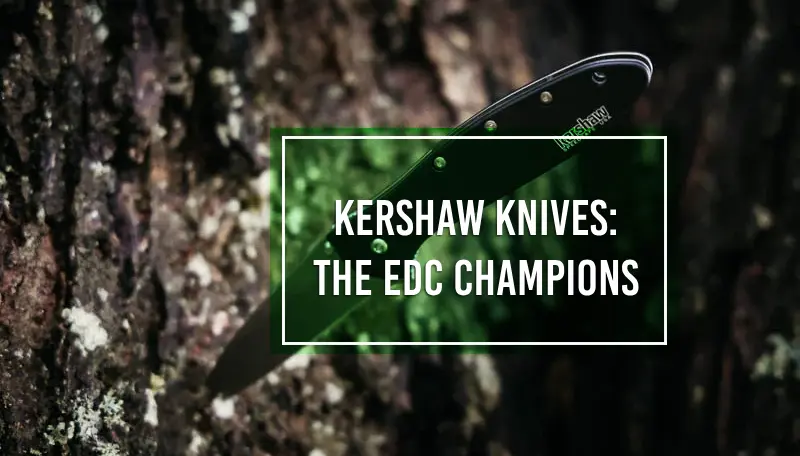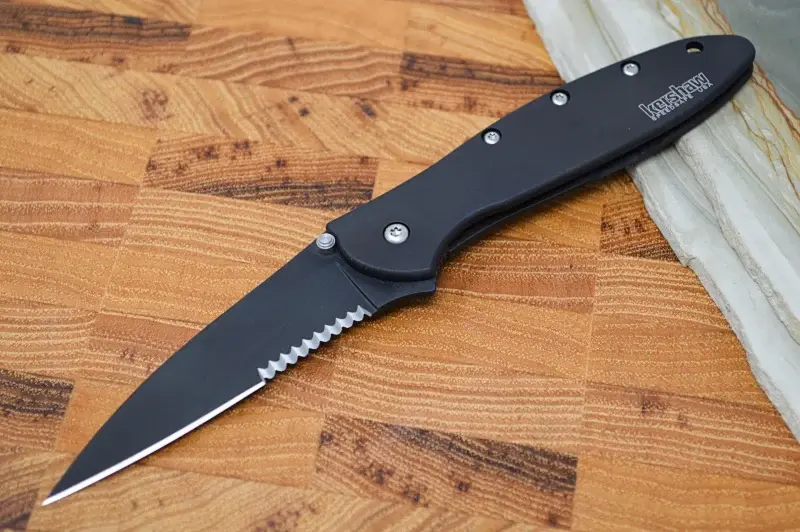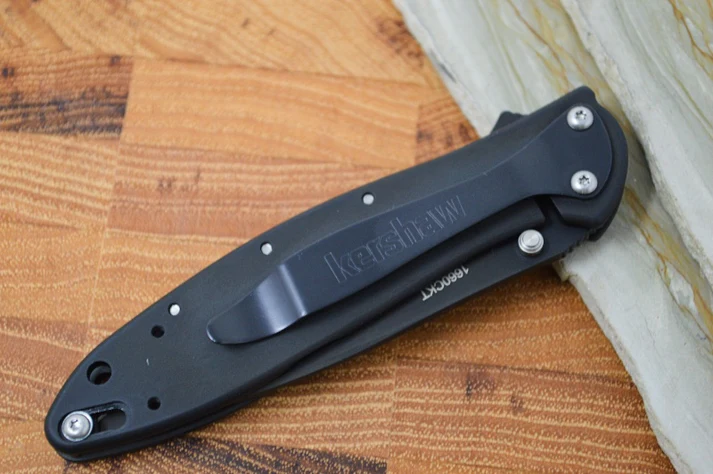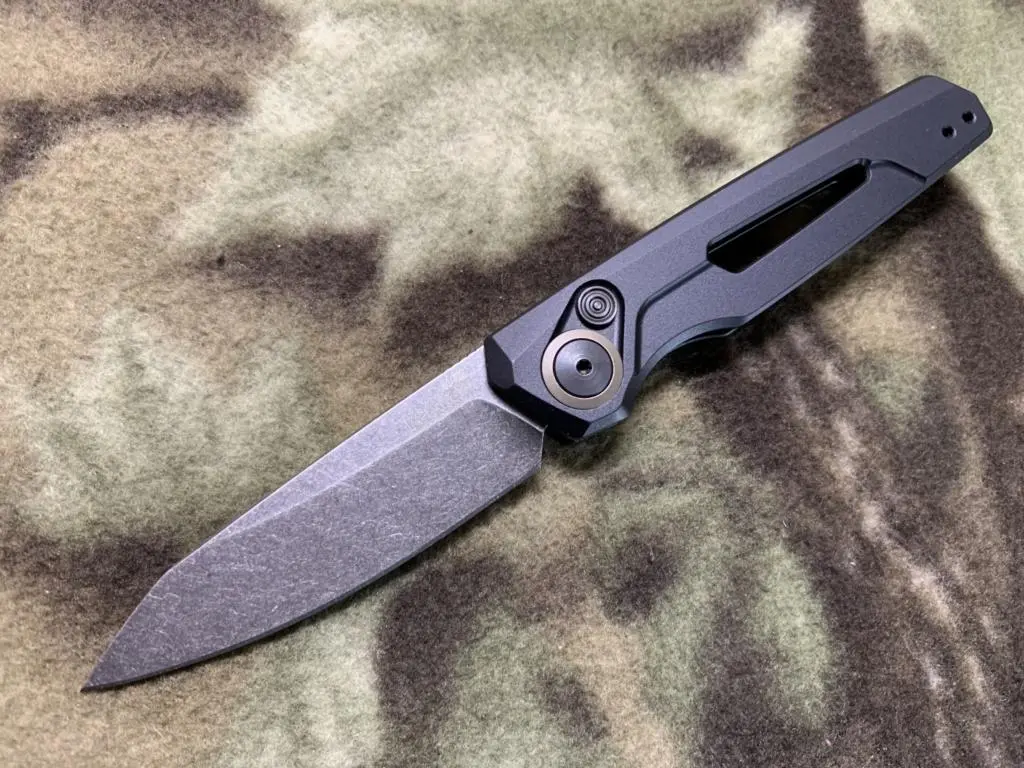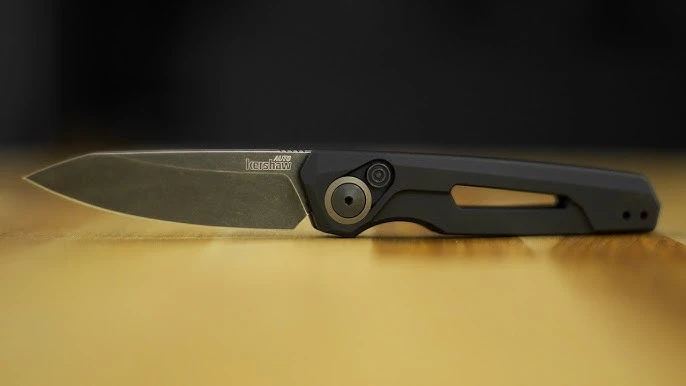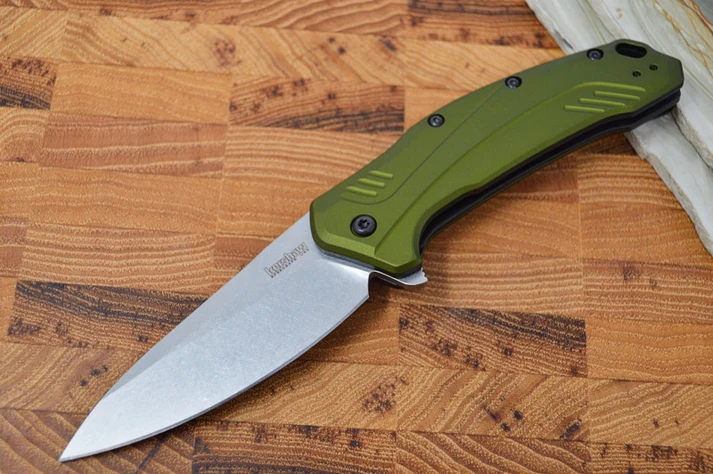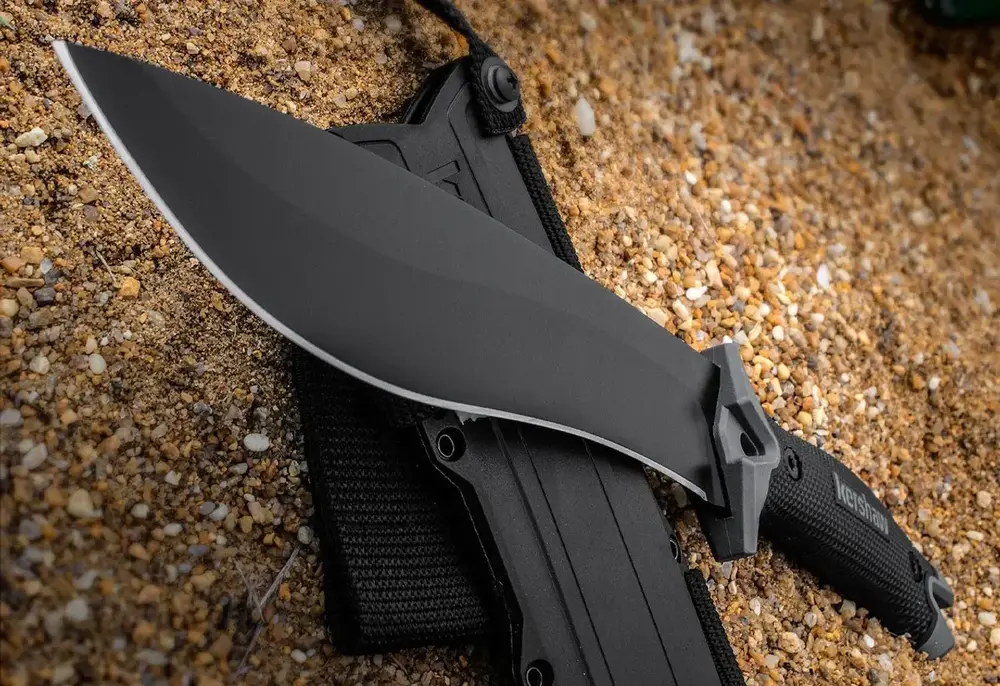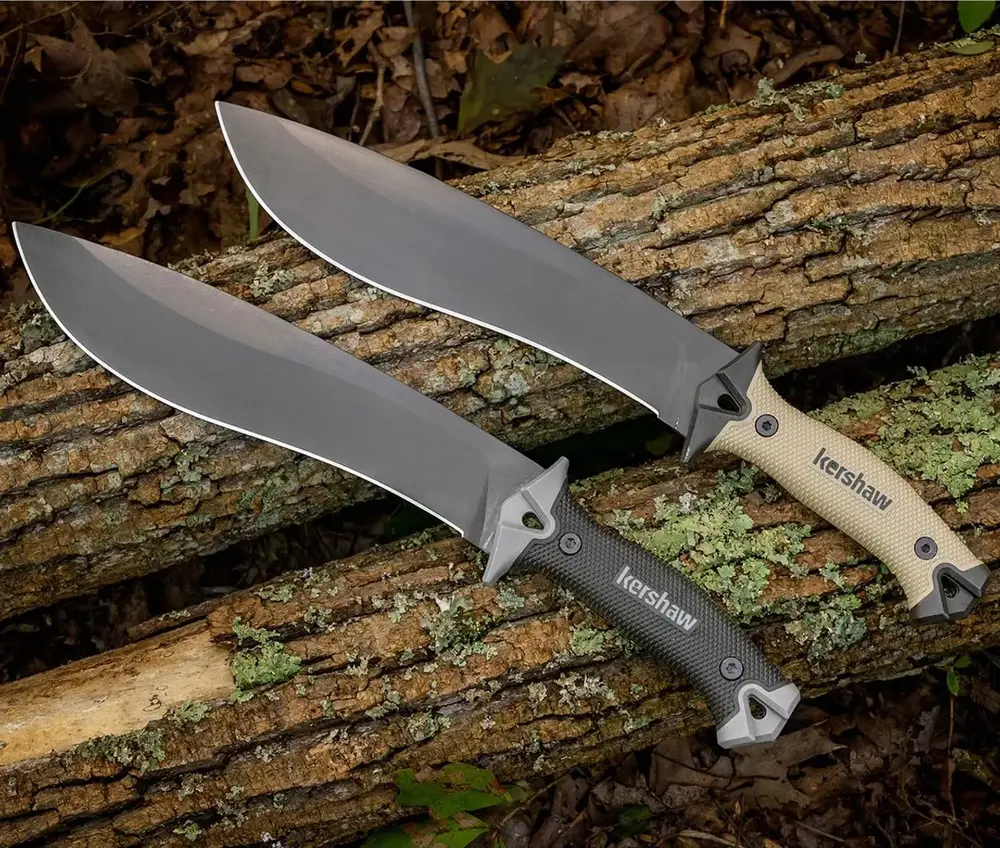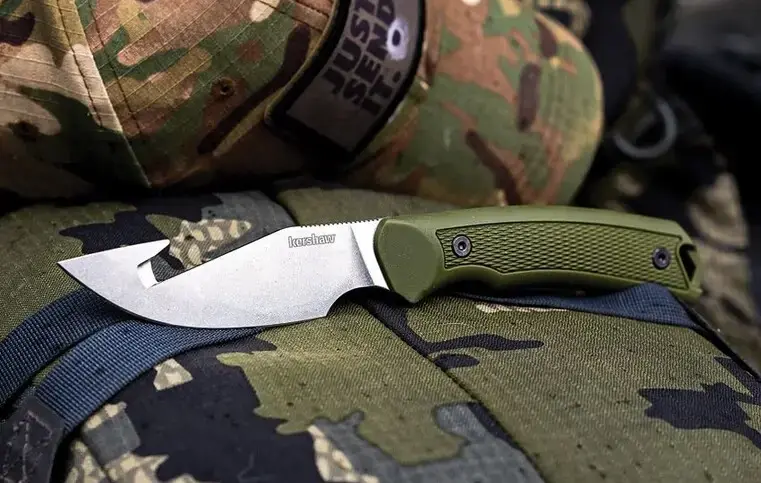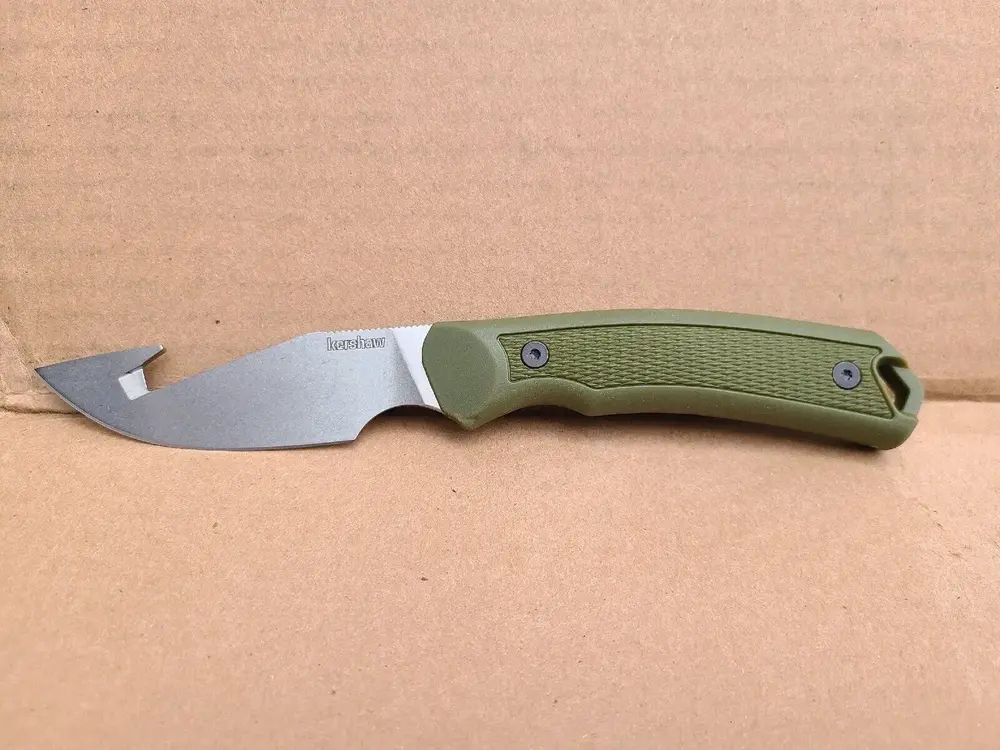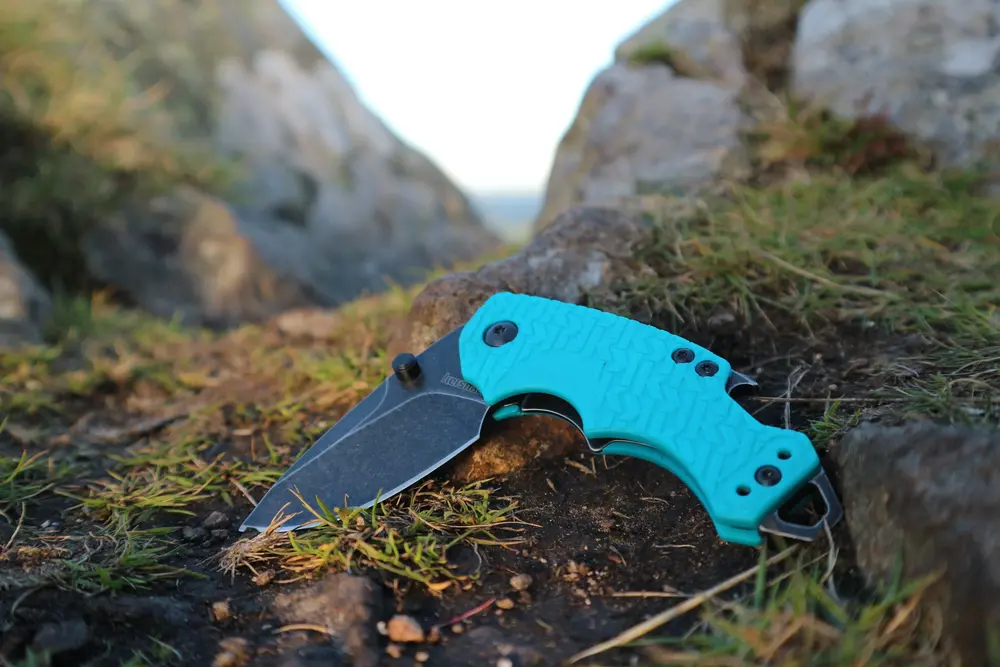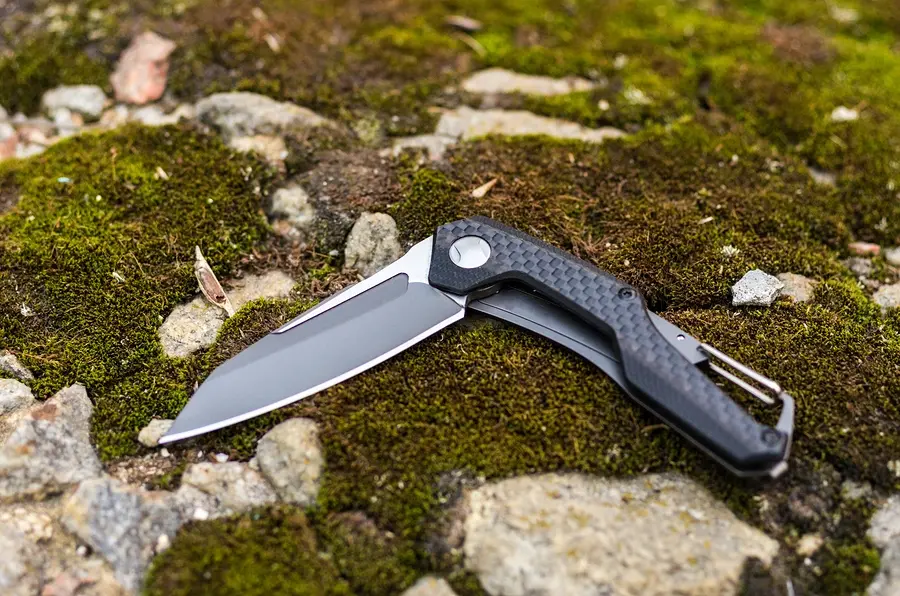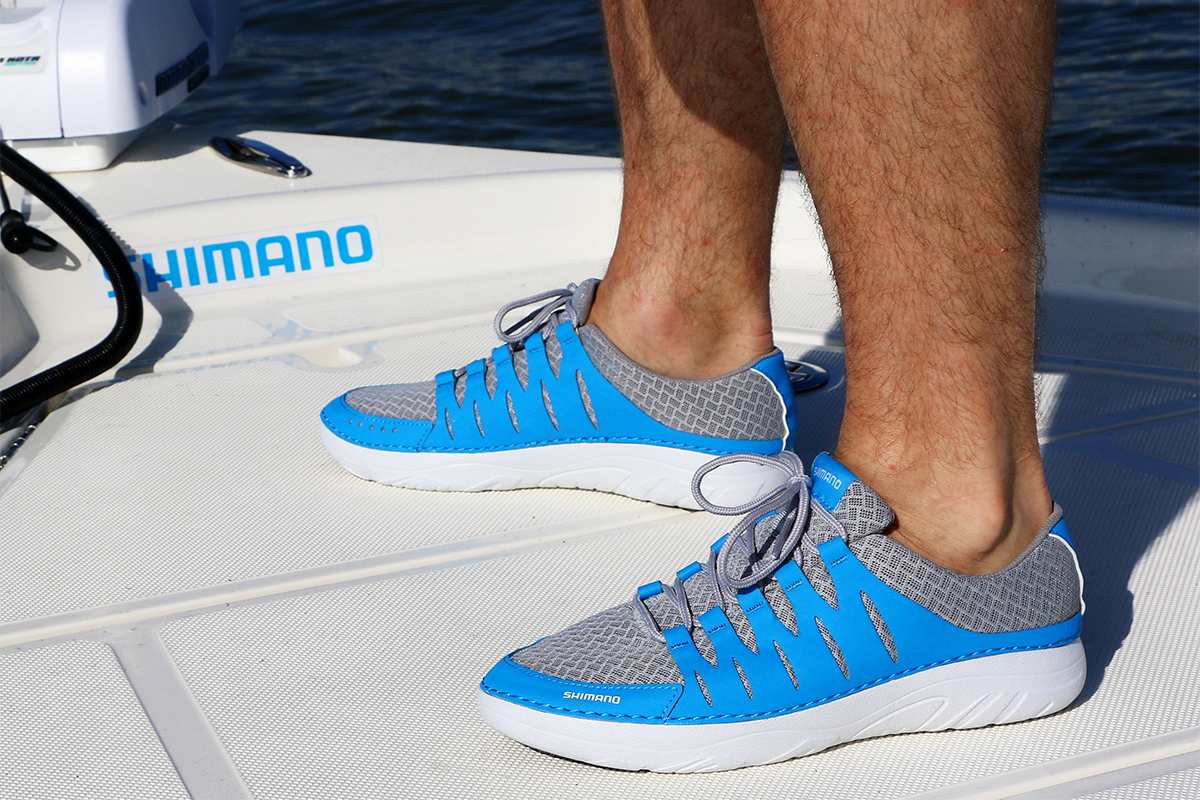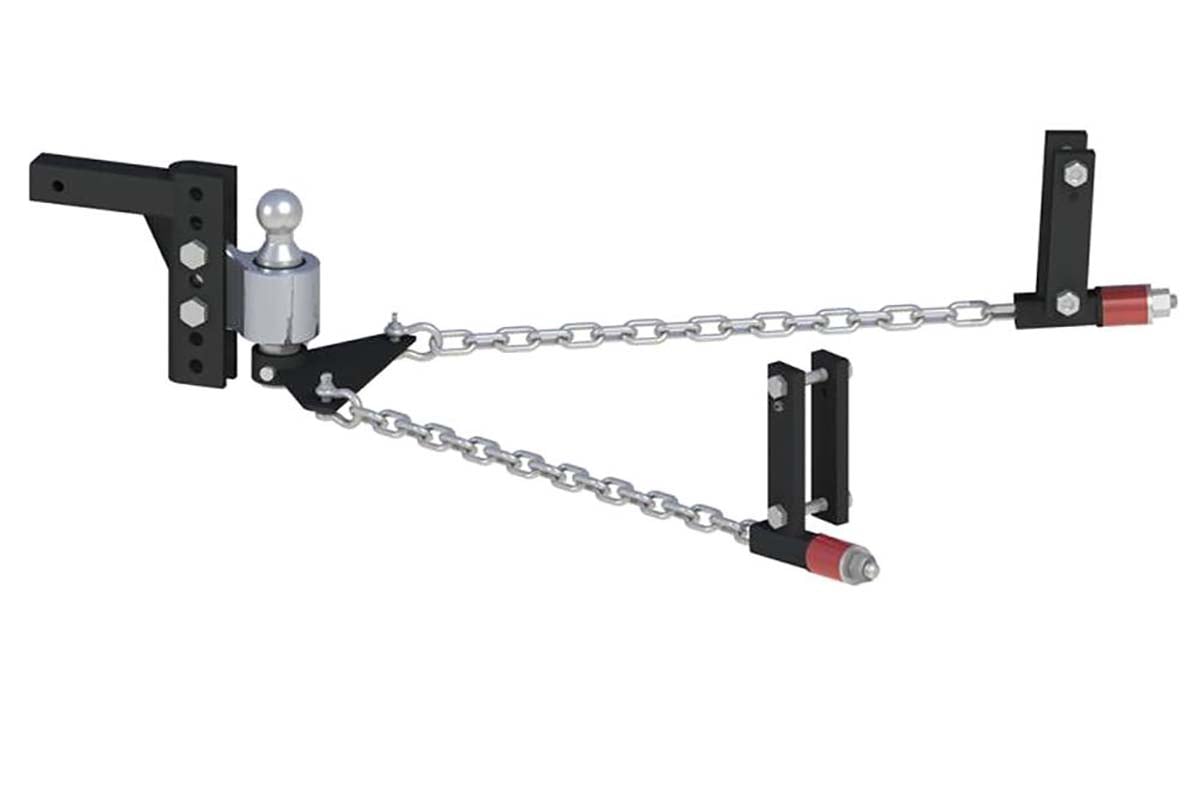It’s hard to think of a task where a knife couldn’t be helpful, one way or another. The ultimate tools, capable of solving countless problems, knives are especially useful when it comes to the outdoors. But even if you don’t find yourself in a specific outdoor-related scenario, a folding knife can still prove useful. And when it comes to reliable, well-crafted knives in general and EDC knives in particular, Kershaw is hard to beat. The brand specializes solely in knives and within fifty years of its operation has mastered the craft of blade-making. With award-winning technologies and advanced materials, Kershaw knives are a testament to innovation, quality, and style. Today, we’ll take a look at six candidates for the place in your pocket. Or a backpack. Or wherever you plan to store it.
Table of Contents
EDC Kershaw Knives
EDC stands for everyday carry, so you can expect these knives to be lightweight and compact. Folding knives are obviously the most optimal option – they retain the functionality of a fixed-blade knife while boasting superior portability, even if at a price of lesser stability and robustness. Folding knives dominate Kershaw’s inventory, so the choice is by no means meager. Here are the three best Kershaw pocket knives.
Kershaw Leek
The Leek series is one of the finest examples of Kershaw’s dedication to excellence. The appearances alone would be enough to coax me into choosing this knife – its sleek and streamlined profile just does the trick for me. But the Kershaw Leek has much more to show for it than its looks.
Construction
The Kershaw Leek features a drop point plain edge blade constructed from high-performance Sandvik 14C28N stainless steel. Kershaw’s steel guide has it that this type boasts excellent corrosion resistance and hardness, the latter I had a chance to see myself. The blade’s Cerakote finish not only adds to its aesthetic appeal but also further increases its resistance to corrosion and wear.
The handle is made from robust 410 stainless steel, contoured for a comfortable grip. It sports the same black Cerakote coating that works both for longevity and visual unity.

KERSHAW Leek 3in Black Folding Knife
$77.51
Price accurate at time of writing
Specs:
- Activility: EDC
- Blade length: 3in
- Knife type: Wharncliffe
- Steel: Sandvik 14C28N, DLC Coating
- Handle: 410 Stainless Steel, DLC Coating
- Weight: 3oz
Blade and Edge Integrity
Kershaw Leek’s blade proved that a pretty face is just one of its merits. I used it on four various materials – cardboard, plastic, a thick rope and a bunch of small branches. All objects required a different amount of effort to cut through, of course, but I never doubted the knife’s ability to finish the job. The blade also remained firmly fixed throughout the whole testing, even against tougher materials.
Ergonomics
Weighing in at just 3 ounces, the Leek is light enough for you to eventually forget you carry it. Its length (7 inches when opened) strikes a perfect balance between portability and functionality.
The handle is pretty comfortable to hold, sleek and smooth. The grip space is somewhat limited, but I didn’t perform any tasks that would call for a more substantial grip, so that didn’t spoil my experience in any way.
The SpeedSafe Assisted Opening system is a true asset. It makes it much easier (or possible at all) to deploy the knife with only one hand using either the thumb stud or flipper. If something makes the knife more convenient to use, I can only appreciate it.
Portability
With a closed length of 4 inches, the Kershaw Leek is compact enough to fit comfortably in a pocket. The included reversible pocket clip makes sure your knife won’t sink into the depths of your pocket, which is also a welcomed feature.
Kershaw Launch 11
The Launch family of Kershaw knives has many fine representatives, the Launch 11 being one of them. Austere yet elegant, it sports a distinct look of the Launch while boasting some features that make it stand out against its brethren.
Construction
The Launch 11 boasts a drop point style blade, the same as the Leek, so you can expect it to be a great all-purpose blade. Made from CPM 154 steel (a high-end, powdered metallurgy stainless steel), the blade boasts excellent corrosion resistance and durability.
The handle is constructed from anodized aluminum, which makes it lightweight yet sturdy. Its black finish provides an elegant contrast to the blade, giving the blade its austere look.

KERSHAW Launch 11 2.75in Black Folding Knife
$119.99
Price accurate at time of writing
Specs:
- Activility: EDC
- Blade length: 2.75in
- Knife type: Drop Point
- Steel: CPM 154, Black Stonewash
- Handle: Aluminum
- Weight: 2.10oz
Blade and Edge Integrity
The Launch 11 proved itself as an exceptional performer. I used all the same materials as in the first test (had to get A LOT of branches in the end). The blade cut through everything I put it against with ease. I would say, though, that its smaller profile was more of a hindrance than help. I don’t have big hands, but I just want the knife to be more substantial. But that’s me, and I understand that in terms of ergonomics, that will only be a plus.
Ergonomics
Weighing just 2.1 ounces and measuring 6.75 inches when opened, the Launch 11 offers a superior balance between weight, size and functionality. It’s lighter and smaller than the Kershaw Leek, which might be both a plus and a minus depending on how you like your knives.
The automatic opening mechanism is undoubtedly one of the best features of this knife and any other Kershaw EDC knife. A simple push of the button deploys the blade quickly and smoothly, and I always appreciate the opportunity to engage a knife with a single hand.
Portability
With a closed length of 3.8 inches, the Launch 11 won’t cause you any discomfort when carried in a pocket. It features the same reversible pocket clip that Kershaw Leek has, which opens up plenty of carrying options.
Kershaw Link
Whereas the two previous models have some features in common, the third EDC knife I’ve tested stands out, at least when it comes to the looks. I found the performance to be on par with the models I’ve already covered, so it all goes down to preferences.
Construction
The Link features a drop-point style blade, like the rest of Kershaw knives. The blade of the older models was made with CPM 20CV blade steel, whereas newer versions sport blades of CPM Magnacut. I’m no steel expert, and Kershaw’s guide sings praises to every type they use in their production (unsurprisingly), but I bet both are good options. I’ve personally tested the CPM 20CV version and it worked just fine.
The handle of the Link is made from anodized aluminum that boasts strength at no expense to the weight, with the machined pattern enhancing the grip.
Blade and Edge Integrity
The blade is the widest of all the EDC carry knives I’ve covered, and that definitely makes things easier when cutting through hardy materials like wood. It required some adjustment in my cutting pattern since I’d tested knives with narrower blades before that, but it definitely got the job done.
Ergonomics
Weighing 4.8 ounces and with an overall length of 7.6 inches when opened, the Link is the biggest EDC knife in this review. That doesn’t diminish its worth, though. It might be a teensy bit bigger, but it’s still designed to be carried comfortably in the pocket. The handle is ergonomically designed to fit comfortably in the hand, especially with its machined patterns.
Portability
With a closed length of 4.4 inches, the Link is compact enough to be carried comfortably in your pocket. The same reversible pocket clip that’s been in every other knife is also present here, and you know how it goes: the knife being easily accessible, and so on.
Outdoor Kershaw Knives
Outdoor knives have two paths of evolution. One is to remain portable and ergonomic not to occupy too much space in the backpack while remaining capable of doing the cutting jobs. The other way is to grow in size and become a fixed-blade knife to offer a superior tool for cutting through materials like wood. I’ll cover one knife in each of those evolution paths.
Kershaw Reverb
The Kershaw Reverb is a compact folding knife that is perfect for outdoor enthusiasts and anyone looking for a reliable tool for backpacking, camping and any other outdoor activity.
Construction
The Reverb features a good old drop-point blade style with a plain edge. The blade is made from 8Cr13MoV stainless steel, and at this point, it makes no sense to even try to understand what that stands for. But Kershaw are worth their salt, and the testing proved this steel is as good as any I’ve tested so far.
Unlike other Kershaw knives covered, the Reverb is a manual folder, meaning there is no button to push to get the knife engaged. You’ll need to open it manually, which isn’t one bit difficult, but it’s a change from a push-button design.
The handle of the Reverb is a combination of G-10 and carbon fiber. That blend makes the handle particularly resistant to the whims of the weather. The handle’s textured surface offers a secure grip, and combined, these features make the Reverb an optimal option for exploring the outdoors.

KERSHAW Reverb 2.5in Folding Knife
$34.86
Price accurate at time of writing
Specs:
- Activility: Camping, Hunting
- Blade length: 2.5in
- Knife type: Drop Point
- Steel: 8Cr13MoV, Titanium Carbo-Nitride Coating, Satin Flats
- Handle: Carbon Fiber, G-10
- Weight: 1.60oz
Blade and Edge Integrity
Being an outdoor-intended knife, the Kershaw Reverb nailed my four-material test. I was especially interested in the rope and branch testing since those materials are much more likely to be candidates for cutting when out in the wilderness. To me, the handle felt more comfortable than that of the Launch 11 knife, and by the time I finished the test, I began wondering whether the Reverb would make for an even better EDC candidate. But then I remembered how it opened and thought it might not be the best option for everyday carry.
Ergonomics
Weighing in at a mere 1.6 ounces and measuring 6.1 inches when opened, the Reverb is the lightest kid on the block, even lighter than regular EDC knives. But despite its small size, the handle still feels nice, so the compactness doesn’t take away from the usability.
The Reverb does not feature an assisted opening mechanism, opting instead for a manual opening design with a built-in carabiner clip. The manual opening works smoothly, but it’s still not the same as automatic. But at least you can rest assured it won’t engage when you don’t want it to.
Portability
With a closed length of just 3.25 inches, the Reverb is as portable as it gets. The built-in carabiner clip is great – you can easily attach the knife to a backpack or belt loop, both are great options for the outdoors.
Kershaw Camp 10
The Kershaw Camp 10 is the first fixed-blade on the list and also the most imposing one. This heavy-duty machete is designed to handle the rigors of outdoor activities while also being a reliable companion in any sort of trouble.
Construction
The Camp 10 features a fixed, recurve blade style perfect for chopping and slicing tasks. The blade is made from tough 65Mn carbon tool steel, used by the brand exclusively in its Camp series.
The handle of the Camp 10 is made from Glass-filled Nylon (GFN), which is both lightweight and sturdy. It sports a Sure-Grip overmold, so even rainy weather won’t make it slip from your hands.

KERSHAW Camp 10 Fixed Blade 10in Knife Machete
$56.09
Price accurate at time of writing
Specs:
- Activility: Camping, Hunting
- Blade length: 10in
- Knife type: Drop Point
- Steel: 65Mn steel
- Handle: Rubber
- Weight: 1 lb. 2.20 oz
Blade and Edge Integrity
I didn’t really bother cutting stuff like cardboard since this “knife”, if you may, is obviously meant for more serious tasks. Wood in its various forms was the main adversary for Camp 10 in my testing. Thick branches, firewood, and then some tough ropes for the last dish. The blade cuts through the wood and plant fibers with ease, and given the size and momentum you can get, it definitely is the ultimate knife for the outdoors. I wouldn’t call it a fair competition, comparing a fixed-blade knife to a folder, but they are all Kershaw, so it doesn’t matter.
Ergonomics
Weighing 1 lb 3 oz and with an overall length of 16 inches, the Camp 10 is a large knife designed for heavy-duty tasks. But the GFN handle is ergonomically shaped, so expect a pretty comfortable grip.
Being a fixed-blade knife, the Kershaw Camp 10 lacks any opening mechanism. However, the knife comes with a molded sheath with lash points and belt loops, so you can either carry it around on a belt or store it safely in a backpack.
Portability
Considering its size, the Camp 10 is nowhere near as portable as a folding knife. It won’t fit in a pocket, unless it’s a really big one, and it occupies some space in a bag. The trade-off is absolutely fair, though.
Hunting Kershaw Knives
Hunting knives are specifically designed to aid in various hunting tasks such as skinning game and cutting up meat. Unlike other types of Kershaw knives, they are typically characterized by their sturdy, sharp blades with a curved edge to facilitate clean cuts and precise work. They often have a single sharpened edge to provide better control and accuracy. They also need to be compact enough to fit into a hunting bag.
Kershaw Deschutes Skinner
The Kershaw Deschutes Skinner is a fixed-blade knife designed specifically for hunters and outdoorsmen. The gut hook reveals its intended purpose right away, but the other side of the blade is just as functional.
Construction
The Deschutes Skinner features a skinning-style blade with a plain edge and thus is perfect for all sorts of hunting tasks. The blade is constructed from 8Cr13MoV stainless steel – we’ve already seen it in the Reverb knife, and it tasted great, so it’s good news.
The handle is made from polypropylene, which turned out to be pretty durable. It also features a rubber overlay to facilitate a more reliable grip.

KERSHAW Deschutes Caper 3.3in Clip Point Fixed Blade Knife
$42.57
Price accurate at time of writing
Specs:
- Activility: Camping, Hunting
- Blade length: 3.3in
- Knife type: Clip Point
- Steel: D2
- Handle: Polypropylene
Blade and Edge Integrity
In the case of the Deschutes Skinner, I decided to perform a bit of meat cutting (since skinning wasn’t really an option at the moment of testing) together with cutting some other basic materials I’ve used so far. The form of the blade made me a bit wary – it looked like a bit more force could break it, but the thickened tip does balance the scales. The knife cuts through flesh pretty easily. I mean, they are all factory-sharpened so all of their magnificent cutting feats might not sound that impressive, but at least it proves the quality standards of Kershaw knives. I did a bit worse with basic materials, but I think you can’t excel in everything.
Ergonomics
Weighing 5.7 ounces and with an overall length of 9.2 inches, the Deschutes Skinner provides a good balance of weight and size. You don’t need to bother with an opening mechanism, since it’s a fixed-blade knife, so yeah, there’s only that.
Portability
With a blade length of 4.6 inches, the Deschutes Skinner is relatively compact for a fixed-blade knife, especially when compared with the previous giant. The included sheath has a belt loop, so you can attach the knife to your belt or backpack, which definitely makes it more portable.
How to Choose a Kershaw Knife
Now, you’ve seen six knives being examined so it might seem like there is nothing more to say. But there’s actually the question of choosing strategy. Of course, the majority of knives featured a drop point blade, so it might seem like it is always the best choice. But it’s not. There are scenarios when other types of blades might be more fitting, and this goes for all the aspects of a knife. Here’s a quick choosing guide in case you become a fan of Kershaw and come to need another knife.
Blade Style
The form of the blade contributes significantly to the knife’s cutting capabilities. Some styles are better suited for piercing and cutting fine materials, while others excel at slicing, trimming and chopping harder materials.
Drop Point Blade
One of the most popular blade styles in Kershaw’s lineup is the drop point, featured prominently in the Leek series. The drop point blade has a convex curve from the spine towards the tip, which gradually drops, hence the name. It is suitable for a wide variety of tasks and thus is considered to be an all-purpose.
Skinning Blade
Kershaw’s Deschutes Skinner features a skinning blade style. Skinning blades have a sweeping curve and a relatively short and narrow point. This design makes it ideal for hunting tasks, particularly skinning game, where the broad sweeping edge helps separate the skin from the meat without damaging either.
Tanto Blade
Tanto blades, like that found in Kershaw’s Brawler series, are characterized by a high point and a flat grind, leading to an extremely strong tip. The design is inspired by traditional Japanese short swords. Tanto blades excel at piercing tough materials due to their robust tip.
Wharncliffe Blade
Wharncliffe blades, such as the one found in Kershaw’s Launch series, have a straight edge and a spine that tapers sharply from the handle to the tip. This design results in a blade that excels at slicing while providing precise control, making it perfect for more detailed tasks.
You can read about other styles on Kershaw’s Blade Styles page.
Blade Edge
Plain Edge
Kershaw offers blades with plain edges, like the Leek and Deschutes Skinner, suitable for clean, precise cuts. The type of steel used is also crucial. High-performance steels like Sandvik 14C28N, used in the Leek, offer excellent edge retention, corrosion resistance, and resharpening easily.
Serrated Blade
Some Kershaw knives, like the Blur, come with a partially serrated blade. The serrations near the handle add versatility, allowing the knife to quickly cut through tougher and fibrous material, while the plain edge towards the tip is ideal for fine, precise cuts.
Opening & Locking Systems
Kershaw knives are renowned for their innovative opening and locking systems, designed to ensure a smooth, fast and secure blade deployment or secure blocking. Here are the options you can find in Kershaw knives.
SpeedSafe Assisted Opening
The SpeedSafe Assisted Opening system is a defining feature of Kershaw knives, including the popular Leek and Launch series. This system uses a torsion bar to move the blade out of the handle, enabling smooth, secure and fast one-handed blade deployment.
To operate, you apply manual pressure to the flipper or thumb stud with a light push or pull back to overcome the resistance of the torsion bar. The blade then opens smoothly and locks into place for confident handling without premature closure. This patented system ensures that you can quickly and safely deploy your Kershaw knife, even when wearing gloves or in high-stress situations.
One-Handed Flipper
In addition to the SpeedSafe system, Kershaw knives often feature a one-handed flipper. This design allows for two options for one-handed blade deployment: you can either push a thumb stud or press a flipper.
The flipper on SpeedSafe-assisted knives should be easy to operate for both left- and right-handed users. And, once the blade swings open and lock into place, the flipper either disappears for aesthetic reasons or remains visible for added finger protection.
Kershaw Tip Lock System
For added safety, Kershaw implements the Tip Lock system on all Leek and Scallion SpeedSafe knives. This simple slider, when engaged, ensures the blade will not prematurely open when not in use. The Tip Lock system is located where the tip of the blade meets the handle scales in the closed position. A press of the thumb activates the Tip Lock for secure, safe knife use.
Conclusion
I’m far from the only appreciator of Kershaw knives. The pace at which these knives gently suggests the brand really lives up to its reputation. Given the variety of options, both in purpose and price point, a Kershaw can become a great entry-level knife or a reliable addition to your existing collection.
Check out other reviews by Gritr Outdoors’ team:
- Unveiling the Best Camping Chairs of 2024: A Comprehensive Review
- Gator Waders Camp Boots Collection: A Comprehensive Review
- Smith & Wesson Breach 2.0 Boots Review
FAQs
Kershaw Knives was founded in 1974 just south of Portland.
The country of origin for Kershaw knives depends on the series. Some of the lines, like Blur, Skyline, Link and Leek are made in the USA, while others, majorly those on the cheaper side, or produced in China.
EDC stands for everyday carry, and EDC knives are lightweight and compact knives that are convenient to carry on a daily basis.
The three best Kershaw pocket knives are the Kershaw Leek, Kershaw Launch, and Kershaw Link.
Kershaw offers blade styles such as drop point, clip point, skinning, Tanto, Wharncliffe, Hawkbill and many others, each suitable for different cutting tasks.
